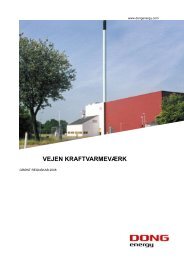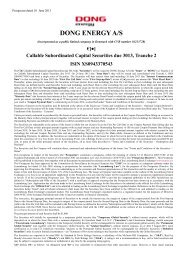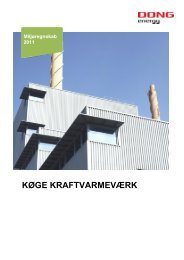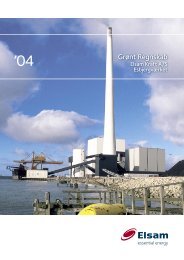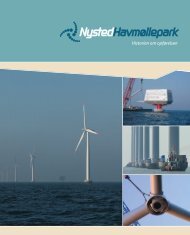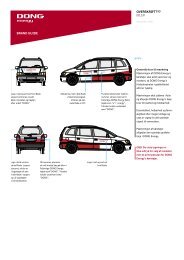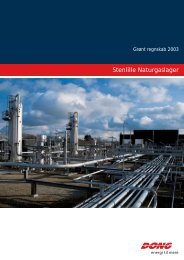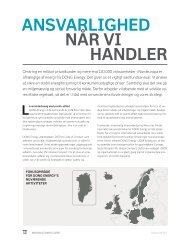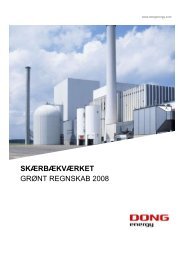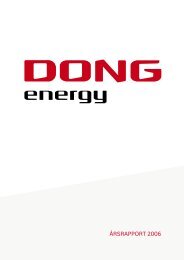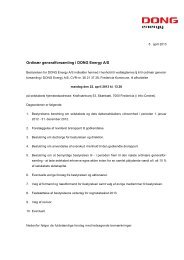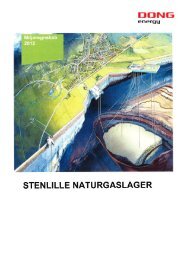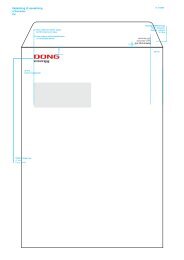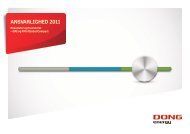ANNUAL REPORT 2011 - DONG Energy
ANNUAL REPORT 2011 - DONG Energy
ANNUAL REPORT 2011 - DONG Energy
Create successful ePaper yourself
Turn your PDF publications into a flip-book with our unique Google optimized e-Paper software.
RIsk AND RISK MANAGEMENT<br />
44<br />
Risk is part of the business for <strong>DONG</strong> <strong>Energy</strong>.<br />
The Group works actively to balance these risks,<br />
so that they either create value or are reduced<br />
Risks are an integral part of <strong>DONG</strong> <strong>Energy</strong>’s business.<br />
Some market risks are managed with a view to striking the<br />
right balance between value creation and associated risks.<br />
Here, movements in market prices can be an earnings opportunity<br />
as well as a competitive parameter. As far as<br />
other risks such as environmental, safety and technical<br />
risks are concerned, <strong>DONG</strong> <strong>Energy</strong> endeavours to completely<br />
eliminate these or, if this is not possible, to mitigate<br />
them as far as possible.<br />
Risk management<br />
The objective of risk management is to ensure that the<br />
risks that may affect implementation of strategy, including<br />
expected earnings, are identified, assessed and form an active<br />
part of day-to-day decision-making process. This helps<br />
underpin and optimise future value creation in accordance<br />
with <strong>DONG</strong> <strong>Energy</strong>’s strategy. In the years to come, the<br />
strategy will contribute to diversifying the Group’s risks,<br />
Selected material risks<br />
Market and credit risks<br />
<strong>Energy</strong> price risks<br />
• Oil and gas price risks<br />
• Price risks for thermal<br />
electricity generation<br />
• Price risks for renewable<br />
generation<br />
• Market trading<br />
Financial risks<br />
• Currency risks<br />
• Interest rate risks<br />
• Liquidity and fi nancing<br />
risks<br />
Credit risks<br />
Regulatory risks<br />
• Regulatory conditions<br />
• Tax regimes<br />
• Financial regulation<br />
partly because <strong>DONG</strong> <strong>Energy</strong>’s international growth will reduce<br />
the relative importance of Danish energy markets.<br />
Material risks can be divided into four main categories<br />
and are, to some extent, interdependent. The Group identifies<br />
and prioritises its risks annually in a risk matrix on the<br />
basis of materiality and probability.<br />
Risk matrix<br />
manaGEmEnt’s rEviEw – <strong>DONG</strong> ENERGY GROUP <strong>ANNUAL</strong> <strong>ANNUAL</strong> <strong>REPORT</strong> <strong>REPORT</strong> <strong>2011</strong> <strong>2011</strong><br />
High<br />
Materiality<br />
Low<br />
Low Probability<br />
Operational risks<br />
• Construction and operation<br />
of facilities<br />
• Subcontractors<br />
• Environment<br />
• Contractual risks<br />
• Partnerships<br />
• Changed demand side<br />
characteristics<br />
• Extensive damage to property<br />
BusinEss pErfOrmanCE<br />
Unless otherwise stated, Management’s<br />
review comments on the business performance<br />
results.<br />
GlOssary<br />
Reference is made to the glossary on<br />
pages 188-189 127-128 for definitions of terms.<br />
The highlighted risks are explained on the following pages.<br />
High<br />
Staff and organisational risks<br />
• Employee safety<br />
• Attracting and retaining<br />
competent employees<br />
• Fraud



